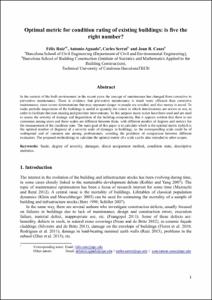Mostra el registre d'ítem simple
Optimal metric for condition rating of existing buildings: is five the right number?
| dc.contributor.author | Ruiz Gorrindo, Félix |
| dc.contributor.author | Aguado de Cea, Antonio |
| dc.contributor.author | Serrat Piè, Carles |
| dc.contributor.author | Casas Rius, Joan Ramon |
| dc.contributor.other | Universitat Politècnica de Catalunya. Departament d'Enginyeria Civil i Ambiental |
| dc.contributor.other | Universitat Politècnica de Catalunya. Departament de Matemàtiques |
| dc.date.accessioned | 2019-04-30T13:02:41Z |
| dc.date.available | 2020-01-26T01:25:32Z |
| dc.date.issued | 2019-06 |
| dc.identifier.citation | Ruiz, F. [et al.]. Optimal metric for condition rating of existing buildings: is five the right number?. "Structure and infrastructure engineering: maintenance, management, life-cycle design and performance", Juny 2019, vol. 15, núm. 6, p. 740-753. |
| dc.identifier.issn | 1744-8980 |
| dc.identifier.uri | http://hdl.handle.net/2117/132413 |
| dc.description | This is an Accepted Manuscript of an article published by Taylor & Francis in Structure and Infrastructure Engineering on January 2019, available online: http://www.tandfonline.com/10.1080/15732479.2018.1557702 |
| dc.description.abstract | In the context of the built environment in the recent years, the concept of maintenance has changed from corrective to preventive maintenance. There is evidence that preventive maintenance is much more efficient than corrective maintenance, since severe deteriorations that may represent danger to people are avoided, and also money is saved. To make periodic inspections of the buildings is useful to quantify, the extent to which deteriorations are severe or not, in order to facilitate decision making and prioritise interventions. To this purpose, many scales have been used and are used to assess the severity of damage and degradation of the building components. But it appears evident that there is not consensus among users and these scales are different between them, with different number of degrees and metrics for the measurement of the condition state. The main goal of this paper is to calculate which is the optimal metric (which is the optimal number of degrees) of a severity scale of damages in buildings, so the corresponding scale could be of widespread and of common use among professionals, avoiding the problems of comparison between different evaluators. The proposed methodology to calculate the optimal metric of a scale can be also extended to other scopes. |
| dc.language.iso | eng |
| dc.publisher | Taylor & Francis |
| dc.subject | Àrees temàtiques de la UPC::Edificació::Manteniment d'edificis |
| dc.subject | Àrees temàtiques de la UPC::Enginyeria civil::Materials i estructures |
| dc.subject.lcsh | Buildings -- Maintenance |
| dc.subject.other | Scale |
| dc.subject.other | degree of severity |
| dc.subject.other | damages |
| dc.subject.other | direct assignment method |
| dc.subject.other | condition state |
| dc.subject.other | optimal metric |
| dc.subject.other | descriptive statistics |
| dc.title | Optimal metric for condition rating of existing buildings: is five the right number? |
| dc.type | Article |
| dc.subject.lemac | Edificis -- Manteniment i reparació |
| dc.contributor.group | Universitat Politècnica de Catalunya. EC - Enginyeria de la Construcció |
| dc.contributor.group | Universitat Politècnica de Catalunya. GRBIO - Grup de Recerca en Bioestadística i Bioinformàtica |
| dc.identifier.doi | 10.1080/15732479.2018.1557702 |
| dc.description.peerreviewed | Peer Reviewed |
| dc.relation.publisherversion | https://www.tandfonline.com/doi/full/10.1080/15732479.2018.1557702 |
| dc.rights.access | Open Access |
| local.identifier.drac | 23661400 |
| dc.description.version | Postprint (author's final draft) |
| local.citation.author | Ruiz, F.; Aguado, A.; Serrat, C.; Casas, J. |
| local.citation.publicationName | Structure and infrastructure engineering: maintenance, management, life-cycle design and performance |
| local.citation.volume | 15 |
| local.citation.number | 6 |
| local.citation.startingPage | 740 |
| local.citation.endingPage | 753 |
Fitxers d'aquest items
Aquest ítem apareix a les col·leccions següents
-
Articles de revista [214]
-
Articles de revista [3.006]
-
Articles de revista [339]
-
Articles de revista [3.265]


